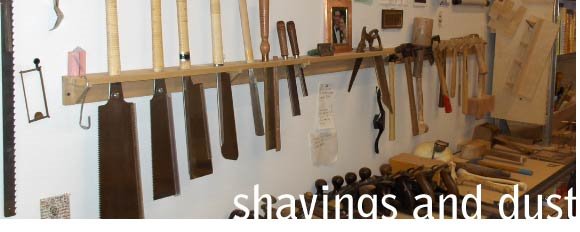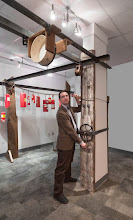Learning Objectives
I believe that design and making are active not passive. We
must be present, committed, thoughtful and directly involved in the world in
order to become agents of positive change.
To this end, I believe that a solid design education has three parts:
inquiry, making, and aspirational thinking.
Inquiry
When I ask a student why they made a particular choice, they
must unpack their own motives and assumptions.
This helps them to be more critical, more aware and more thoughtful as
they engage in the design process. So often we can be unaware of the questions
we are really asking, and this is especially true in young designers. Students in our senior thesis class (a
two-semester required course), determine for themselves the subject of their
individual projects. The only
stipulations are that the thesis must be applicable in Syracuse NY and respond
to a demonstrable need in this locale.
This encourages them to directly engage local communities, to research
existing social and cultural conditions and to think critically about their
response to those conditions. Students
guide their own studio work through discussion with each other and with the
other stakeholders in the project.
One process that I began implementing three years ago as a
research tool is a volunteering requirement. Each student is required to
volunteer for at least 25 hours with a group or organization in Syracuse. This gets them “out of the bubble” of our
University and into the community that surrounds us. For many of our students this is the first
time that they have spent any time with people from a socio-economic background
that differs from their own. By adding
this set of first-person experiences to their academic research, they are able
to create richer and more responsive designs as a part of their thesis work. One student wrote in an end-of-semester
evaluation “I had no idea about the assumptions I was making until I spent time
with [a client at the Food Bank]. It
really changed my design and it also changed my life.” This is slightly grand perhaps, but this
student’s ultimate design did shift from a relatively shallow redesign of a
community center/soup kitchen into an examination of food systems in Syracuse
and an exploration of food inequities.
This act of asking, this process of inquiry is not an isolated
step in the design process or the learning process. All the way through it is imperative that we
step back and look critically at the questions we are asking. I create opportunities for our students to
present their questions to their peers, to me as a faculty member, and to
visiting lecturers as a way to ask, “are the questions I am asking really the
questions I should be asking?” This
process of research and evaluation is carried through the entire design process.
Making
Making is important and relevant and irrespective of
discipline everything we design must be made by someone somewhere. I love
making of all types, and I am vocal about that. The deeper each student’s
understanding of which making, manufacturing, and building processes can be drawn
upon to realize their design, the more complete their design approach is. To
this end, whether it is in my interior design first-year studio, my senior
thesis studio, or my furniture design classes, making is built into the
syllabus. There is an attention to detail and a respect for precision that is
taught better through the end of the finger than through the eye and the
ear. Though cutting cardboard may seem
trivial in the grand scheme of a design education, there is a patience and
precision and response to material that is learned by doing that can not be
adequately communicated with lectures.
In the process of making models in first-year studio the students learn
these skills (patience and precision) as well as learning that there are limits
to and possibilities provided by each material.
These limits and possibilities are a part of our design lexicon, they
enable us to do the work that we do and to do it beautifully and well.
This process of practice extends beyond objects and spaces
and into relationships. Every design is
about relationships, and cultivating those relationships is an important part
of our job as a designer and as a teacher.
When the students are doing their volunteer work, they learn by
experience this first-hand: They must
listen respectfully and critically, often having to go to great lengths to
tease out information that they can apply to their design. This making of relationships is an important
skill that is (like cutting cardboard) best learned by practicing, inside and
outside of the classroom.
In my own work I have spent years learning to be keenly
aware of the material I work with, its origins and its story. It is important to me to put that story into
the finished piece somehow, and to communicate it to the clients or users. I believe that this helps the user connect to
the finished piece and gives it a higher personal value, and it is my hope that
a higher value leads to a diminished chance that the object will be cast aside
and added to the waste stream. This awareness of our place in the cycle of
creation (as users and waste creators) colors every design decision I make,
from materials to processes. It drives
me to seek out methods that have the smallest possible negative impact
environmentally, economically, and socially, and the greatest positive
impact. It also drives me to communicate
this thought process to my students.
This method of thought spills over into my teaching of course: There is no shred of knowledge, no bit of
experience that cannot be utilized as an educational tool. The way that leaves fall off of a tree in
autumn, the way two people pass each other in a hallway, the relationship of
bone to muscle to skin in our hands, all of these are clues to the way the
world works. We can use these as
signposts when we engage in our creative process; we can let them lead us to a
more thoughtful, appropriate finished piece.
Aspiration
I believe that what we do as designers and makers is
important; it will change the world.
Even something as simple as making a mark on a piece of paper changes
the world from a world without that mark to a world with that mark. If this is
true, if every design perforce changes the world, I believe we have a
responsibility to do that in a positive way.
I believe that by teaching students the art of inquiry and the craft of
making I am able to help widen what I call the student’s “field of view.” We can easily fall into the trap of thinking
too narrowly, of ignoring the interconnected nature of the world around
us. But every choice we make has effects
that ripple outward, and choosing one material (for example) over another or
one construction method over another can have profound impact on all manner of
other disciplines and industries. To this end, I pursue projects for my
students that respond to that agenda, seeking out socially and environmentally
responsible real world clients like e2e Materials (a local sustainable-product
business), or community gardens and other community centers.
As field of view broadens, as we become more aware of the
interconnected nature of the things and processes and people in the world
around us, we are able to identify and mitigate the relationships that we are
working to improve in a much more sensitive way. Sometimes this process is simple: Critiquing a first-year student’s drawing and
noting the lack of crown and base molding in the drawing can lead to a
discussion about the role of molding in an interior first as way to keep out
the cold, then as a status symbol, then (by doing away with it altogether) as a
Minimalist statement about æsthetics.
Other times it is more complex: a
discussion with a thesis student about generational poverty leads to insights
about the role that government-built housing (built cheaply and often with
little thought about the relationship of the residence to the end user) can
play in underlining and even creating attitudes about class-identity and
self-identity.
These three components (inquiry, making, and aspiration) are
not steps in a process, rather they are twisted around each other like strands
in a rope: they start together and
support each other and run concurrently all the way through the process
arriving together at a student who graduates engaged with the world, looking
critically at that world, and ready to make positive change within that world.


No comments:
Post a Comment